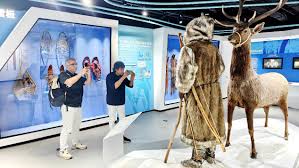Foreign
Seize opportunities for better future of Chinese science fiction

By Liu Cixin
I ventured into the realm of science fiction creation, deeply inspired by the wonders of science.
I can still vividly recall the exhilaration I felt when reading the news of the first landing by humans on the moon in my childhood. Over the years, I have imagined countless scenarios of Chinese astronauts walking in space. Now, when I see the frequent launches of the Shenzhou spaceships, and watch Chinese astronauts on space missions on TV, I am occasionally overwhelmed by a surreal feeling – are these truly happening?
In recent years, China’s science fiction industry embraced rapid development and received wide attention. This couldn’t have happened without the overall progress of society, including advancements in the aerospace industry and the wide application of Internet technologies. We are amid rapid modernization, industrialization and digitalization, with opportunities and hopes, as well as pressure and challenges. We marvel at the wonders of science, and expect science and technology to bring a better life to human beings. These all provide a fertile ground for the prosperity of the science fiction industry.
Science, the source of strength for science fiction
Science fiction is an outcome of the modern scientific and technological revolution. In the early 19th century, scientific and technological advancement promoted industrial revolutions and triggered people’s imagination and aspirations for the future. That was how science fiction literature came into being.
As mankind entered the age of electricity from the age of steam between the 1920s and 1960s, the progress of science and technology once again demonstrated the overwhelming power to change the world. The revolution in physics, represented by the theory of relativity and quantum mechanics, has brought people whole new horizons. People’s admiration for the power of science and the longing for the future reached a climax during this period, leading to a flourishing era for science fiction works.
Based on science, science fiction creates a sci-fi universe different from the real world. Although science fiction writers imagine the future worlds, they aim not to predict them. It doesn’t really matter whether a science fiction book’s predictions come true in the future when evaluating its quality. Many science fiction writers, including myself, intentionally choose settings that are unlikely to be realized to tell stories, and use novel perspectives to show the wonders and marvels of science, thus allowing people to experience the beauty of science.
After 200 years of development, countless science fiction works have already envisioned the future in various ways, and it is sometimes questioned whether science fiction will continue to be creative in the future. In my opinion, the creativity of science fiction is infinite. Even traditional themes can be revitalized, depending on how you portray them.
For example, the classic science fiction short story “A Walk in the Sun” depicts a sole survivor of a terrible crash landing on the moon, who must keep walking continually on the surface of the moon to stay in the sunlight with a wing-like solar panel, in order to stay alive. This is a straightforward narrative with a classic moon landing theme, yet it is amazingly well-written.
In my perspective, as China’s aerospace technology continues to advance, it would be a big hit to use a “micro-realism” approach to depict how an engineering team builds a space power station and a lunar base.
Moreover, with progress in science, new fields will constantly emerge, offering new themes for science fiction. Highly developed modern scientific fields, such as physics, cosmology, and molecular biology, show us a more magical, broader, and more unpredictable universe and nature, which contain rich resources for science fiction creation. However, they also make basic science today more complicated in theory and more difficult in mathematical expression, which is hard for non-professionals to understand. How to fully tap into these resources is a great challenge for science fiction writers, and also a hope for the development of science fiction literature.
In the face of the unknown, science fiction should always present fresh, original and surprising concepts to keep readers interested. To achieve this, science fiction writers should always maintain a young mindset, keeping their imagination in sync with the times.
To release beauty from scientific equations
Expanding people’s imagination is an important mission of science fiction. The well-known “Gravity,” a very pure science fiction movie, shows us that for science fiction creation, the most important thing for the creators is to have a poetic feeling towards the universe. Good science fiction works present to us a drop of water from a perspective of the vast ocean, bringing people out of their limited vision to experience a broader world beyond reality.
Science is the source of strength for science fiction, while the beauty of science is often confined within scientific equations. Ordinary people need to make tremendous efforts to catch a glimpse of its brilliance. But once it is presented, its impact and power of purification to our soul are immense, which is difficult to be achieved by other genres of literature. Science fiction is a bridge to the beauty of science, releasing this beauty from equations and presenting it to the public.
The success of science fiction largely depends on the attraction of their mind-blowing imagination. The Big Bang theory of modern cosmology is spectacular and awe-inspiring. The long journey of life evolution is twisted and romantic. The poetic view of spacetime in general relativity, the magical microcosm in quantum physics… The worldview revealed by science is far beyond our imagination. How can writers present such beauty of science?
“Macro-detail” is a technique exclusive to science fiction literature. Although every narrative needs details, the treatment of details has evolved in science fiction. I can imagine a short story—I will call it “Singularity Fireworks”—which describes a group of super-consciousnesses for whom the Big Bang is nothing more than a firework display. The work uses a few words to depict the talks and feelings between two entities before and after the firework, yet it encompasses the history of the universe since the Big Bang in spacetime, unfolding a vision of a supra-cosmos beyond our universe. In my opinion, this kind of “macro-detail” best embodies the characteristics and advantages of science fiction literature.
Since engaging in science fiction creation, I have been looking for story resources from scientific and technological advancements, endeavoring to express the direct and tangible connection between the insignificant human and the grand universe based on scientific principles. In the beginning, the universe was smaller than an atom, and everything was one. This determines the natural connection between the minuscule parts of the universe and the grand whole. Even though the universe has expanded to today’s scale, I believe this connection still exists, and the evolution and changes of the universe are closely related to the lives and destinies of every human being. When I create stories, I always endeavor to envisage several scenarios of the specific connection between humans and the universe, and turn this imagination into captivating and uplifting tales.
Of course, science fiction does not always depict the future and imagination; it also encompasses the present and reality. Taking my novel “The Three-Body Problem” as an example. The first part portrays a fictional past with a strong sense of reality, in order to spark readers’ imaginations. The second part is a long journey from reality to imagination. The third part is a pure science fiction novel with a prominent “science fiction fan” vibe. Starting from reality to a distant and ethereal world is a typical structure of traditional science fiction, and also a narrative mode that Chinese science fiction readers are accustomed to, from reality to the future.
To seize the chance for innovative development
Science fiction movies have had a significant impact on me. The way I tell stories and construct visual imagery are both influenced by science fiction movies. Images are powerful, and many imaginative concepts in science fiction can only be portrayed through visual means. In this regard, films have a significant edge over printed words.
However, due to the low publishing cost and the relatively fixed readership, authors have more room for creation and can explore more innovative ideas and storytelling techniques. The production cost of science fiction films is much higher, as they need to fight for a wider and more diverse audience’s attention. Films need to consider audience acceptability of innovative forms and content, and find a balance point in artistic expression.
In recent years, both science fiction literature and films have played to their respective strengths. The adaptation of some science fiction novels into films and TV series has brought science fiction to a wider audience, driving the growth of the science fiction industry. To further develop science fiction literature today, efforts should be made to expand the pool of Chinese science fiction writers, so that more talents and works will emerge. The development of science fiction films and TV series requires an increase in talent and experience reserves, providing more opportunities for the new generation of screenwriters, directors, and producers to participate in creation. Additionally, it is crucial to strengthen international cooperation and accumulate more mature production experience.
Promoting the development of science fiction raises new requirements for literary theory and reviews. For example, the technique of “macro-detail” and other science fiction creation methods urgently need theoretical refinement to form a conscious expressive technique. Science fiction criticism also needs to keep pace with the times, breaking free from the constraints of using an outdated perspective to view new works and phenomena. Innovative theories and sharp, vibrant comments can certainly drive the development of science fiction creation.
Science fiction works contribute to cultivating the science fiction imagination of young people, stimulating their creativity and innovation abilities. Science fiction education can be properly introduced into school education, by adding science fiction content to textbooks, or cultivating children’s interest through online science fiction creations. It is believed that a considerable number of young readers and viewers will enjoy science fiction, thereby initiating a conscious exploration of science fiction and science.
Chinese science fiction has shown great momentum and potential. We must seize this opportunity to make the industry stronger.
(The article is compiled by Dong Yang based on an interview with Liu Cixin.)
Liu Cixin was born in Yangquan, north China’s Shanxi province in 1963. He has a bachelor’s degree and is a senior engineer, as well as a science fiction writer and a member of the China Writers Association. His representative works include the novels “Supernova Era,” “Ball Lightning,” and “The Three-Body Problem” trilogy, as well as short fiction such as “The Wandering Earth,” “The Village Teacher,” and “Full Spectrum Barrage Jamming.” “The Three-Body Problem” trilogy is widely regarded as a milestone in Chinese science fiction literature.
Foreign
Discovering culture and friendship in China’s ‘Snow Capital’ Altay

By Huan Xiang, Han Liqun, Hu Renba
Altay Prefecture, located in the northwest frontier of China, sits in the northeast part of Ili Kazak autonomous prefecture in the north of Xinjiang Uygur autonomous region. It borders Mongolia to the east, Kazakhstan to the west, and Russia to the north.
From the pristine Kanas Lake, hailed as “a pure land on earth,” to the majestic landscapes of Koktokay and to the millennia-old rock paintings that earned Altay its global reputation as the “cradle of skiing,” this land is distinguished by its breathtaking natural beauty and profound cultural heritage.
“Come here, try our kebabs!” called out a man in slightly accented Mandarin. He is Percev Timofei Nikolayevich, affectionately known as Jima, a Kazakh national who now co-owns a barbecue restaurant in Beitun, Altay Prefecture, with his Chinese wife, Guan Xinlan.
Their story began at the Jeminay Port, a long-standing border crossing at the convergence of China, Kazakhstan, Russia, and Mongolia. With over a century of trading history, the port has long served as one of the most accessible gateways for China’s commerce with the three neighboring countries.
Since reopening more than 30 years ago, it has quickly regained its role as a regional trade hub. Spotting the opportunity, Guan opened a small eatery near the port in 2005 and learned Russian to serve foreign customers.
Jima, a long-haul truck driver on the China-Kazakhstan route, soon became her de facto language tutor. Known for his warmth and generosity, he helped Guan learn Russian while also supplying her with specialty ingredients from Kazakhstan. Their relationship blossomed, and the couple married in 2009. Jima chose to settle in Altay, where he now helps run their growing business.
In recent years, improved customs efficiency and a mutual visa exemption agreement between China and Kazakhstan have significantly facilitated cross-border movement. For Jima’s family, the prosperity of the port has laid the foundation for a fulfilling life. The booming popularity of Altay as a cultural and tourism destination has opened new opportunities. In April this year, they relocated their restaurant to Beitun, expanding their reach with signature Russian-style kebabs.
From truck driver to entrepreneur, Jima has made Altay his second home. “Altay is beautiful and well-connected, attracting visitors from neighboring countries and beyond,” he said.
Altay’s mountainous terrain is covered in snow for nearly a quarter of the year. In 2018, China’s National Climate Center recognized Altay as the “Snow Capital of China.” The region’s core ice-and-snow area spans more than 30,000 square kilometers, comparable to the Alps in Europe or the Rockies in North America, making it one of the world’s premier destinations for ski tourism.
In 2005, a herder discovered ancient cave paintings in an Altay valley depicting humans skiing on primitive boards with a single pole in hand to hunt. Confirmed by researchers, these drawings represent the earliest known evidence of human skiing activities, dating back between 10,000 and 20,000 years ago.
At an international seminar on ancient skiing culture held in Altay in January 2015, more than 30 experts from 18 countries, including Norway, Sweden, and Finland, reached a consensus recognizing Altay as the birthplace of human skiing.
Nestled in the Altay Mountains, Altay is often described as “a city built within a ski resort.” Its Jiangjunshan International Ski Resort, just 1.6 kilometers from the city’s central square, holds a national 5S alpine skiing destination. With annual snowfall depth exceeding two meters, its light, fluffy powder snow has earned it the nickname “Asia’s powder snow paradise.”
The resort also reflects the growing internationalization of China’s winter sports. “We’ve seen an increase in foreign visitors in recent years, from tropical countries like Malaysia to traditional winter sports nations such as Russia, South Korea, and Japan,” said Li Xia, head of the Jiangjunshan Mountain Ski Academy.
Altay has rapidly expanded its ski infrastructure in recent years. Apart from major resorts such as the Jiangjunshan and Koktokay international ski resorts, recreational ski facilities have been established in every county. During the most recent snow season, Altay welcomed 1.408 million ski tourists, a 23.37 percent year-on-year increase.
In Altay, traces of early human skiing meet the vibrancy of a modern, international winter sports hub. With snow as a bridge and culture as its core, this borderland continues to foster stories of friendship and connection.
Foreign
Shared development: a strategic response to global challenges
By He Yin, People’s Daily
On September 23 local time, China hosted the High-Level Meeting on Global Development Initiative (GDI) at the United Nations (UN) headquarters in New York, announcing new steps to advance the initiative with the international community. A statement was issued at the meeting, reaffirming the consensus to prioritize development and deepen cooperation under the initiative.
At a time when global development faces challenges, China is committed to building consensus and mobilizing international cooperation to drive the GDI forward, injecting strong impetus into addressing development difficulties worldwide and accelerating the implementation of the 2030 Agenda for Sustainable Development.
Development remains an eternal theme of human society and the key to people’s well-being. The UN Charter enshrined development as one of the organization’s founding purposes.
In September 2021, Chinese President Xi Jinping proposed the Global Development Initiative at the general debate of the 76th session of the UN General Assembly. With the broadest interests of humanity in mind, he called on all parties to stay committed to development as a priority, to a people-centered approach, to benefits for all, to innovation-driven development, to harmony between man and nature, and to results-oriented actions.
Since its launch, the GDI has provided a practical framework for renewing global cooperation on common development. Against the backdrop of rising unilateralism and protectionism, which have severely undermined international development cooperation, the world economy has lost momentum, and the development divide between the North and the South has continued to widen.
In this increasingly challenging environment, the GDI has gained relevance and traction as a guiding framework for reinvigorating international development cooperation. To date, over 130 countries and international organizations have taken part in the implementation of the GDI. The UN has established a GDI implementation work group, and the China-Africa-UNIDO Center of Excellence has been inaugurated.
As China’s proposals turn into international consensus and the country’s visions for inclusive development translate into concrete actions, the GDI is increasingly recognized as a global public good aligned with the needs of the times.
UN Secretary-General Antonio Guterres affirmed that the GDI is totally compatible with the Sustainable Development Goals (SDGs) and directly addresses the development challenges confronting the international community.
China has always championed win-win cooperation and common development, advocating joint efforts to make the development pie bigger. The GDI embodies this approach through concrete action.
At a time when some developed countries have fallen short on development-finance commitments or reduced support for international institutions, the initiative has mobilized tangible resources and partnerships to support common progress.
In the past four years, the initiative has mobilized more than $23 billion to support the development and revitalization of the Global South, and launched over 1,800 cooperation projects. From technological cooperation to capacity building, from poverty reduction and education to the digital economy, from high-yield rice to fungus-based processing, and from child nutrition and health to women’s economic empowerment, GDI cooperation has delivered tangible benefits and strengthened local development capabilities.
These efforts have demonstrated that China’s philosophies and agenda of common development not only help countries address pressing challenges, but also provide strong momentum for advancing the broader cause of global development.
Facing new circumstances and challenges, China remains firmly committed to advancing common development. It recently announced that it would forgo any request for new special and differential treatment in current and future World Trade Organization negotiations. This decision demonstrates China’s firm commitment to safeguarding the multilateral trading system and carries clear development significance. It will help refocus the multilateral trading system on development priorities and enhance the inclusiveness and universality of international trade.
China also announced a package of concrete measures: over the next five years, it will implement another 2,000 “small and beautiful” livelihood projects in developing countries; establish a funding program dedicated to digital capacity-building within the Global Development Capital Pool; put forward a new AI+ International Cooperation Initiative; carry out 200 maritime development cooperation projects; and implement a Clean Stove Project in developing countries.
These initiatives will accelerate the implementation of the UN 2030 Agenda for Sustainable Development, and enable more developing countries to seize the opportunities of technological transformation and green transition.
On the path of development, no country or individual should be left behind. This simple yet profound vision animates the GDI and is integral to building a community with a shared future for humanity. China stands ready to work with all parties to use the GDI as a platform to upgrade cooperation, prioritize practical actions, and achieve shared benefits, so that the fruits of development will better benefit people around the world.
Foreign
Farming made easy: how an APP is revolutionizing rural harvests in E China’s Jiangxi

Yang Yanfei, People’s Daily
At 8 p.m. in Longyun village, Yantian township, Anfu county, Ji’an, east China’s Jiangxi province, Li Minggui reclined in his rocking chair after a long day, chatting with his wife about the rice harvest.
Li is the head of the Yantian comprehensive agricultural service center. While most parts of Jiangxi are racing to complete the double-cropping rice season, hilly villages like Longyun began harvesting their single-cropping rice in early September.
As the couple spoke, Li’s phone rang. “Hello, this is from Walou village in Xukeng township. I got your number through the Ganjitong farm machinery dispatch system. Do you have time tomorrow? The weather looks good for drying grain,” said a farmer on the line.
“No problem, but the dew is heavy in the morning, so you have to wait until 9 a.m. I’ll send our veteran, Min Lixiang, to lead the team,” Li replied.
At 3 p.m. the next day, Min and his team had wrapped up work in Walou village and were already operating their harvester in Tuqiao village, also in Yantian. The machine roared through the paddies, pulling in golden stalks of rice with each pass.
On the edge of the field, Min carefully maneuvered the machine, adjusting angles to sweep up even stray stalks with precision. Watching closely, Li gave him a thumbs-up: “Min’s got real skills. He keeps losses to a minimum. Farmers from all around ask for him during harvest.”
“We can always count on Min,” said local farmer Zhou Hailiang with a grin. “Yields look solid this year, around 700 kilograms per mu (about 467 kilograms per hectare).”
“I signed up for full-service farm management this season. Li has been guiding me through every step,” Zhou added, gesturing toward Li.
“With the Ganjitong app, farmers can order services just like takeout, from seedling cultivation and plowing to transplanting, pest control, harvesting, and drying,” Li explained. He keeps over 300 farmers’ contacts on his phone and handles dozens of requests daily. The center’s five harvesters have been running full tilt since the season began.
Anfu county has established several such agricultural service centers, offering integrated, one-stop solutions that cover the entire cycle from seed to harvest.
As one of Jiangxi’s major grain-producing counties, Anfu manages roughly 880,000 mu (around 58,700 hectares) of cultivated land. The combination of full-service centers and digital, on-demand platforms has given local farmers more flexibility and peace of mind.
According to Ouyang Suqin, head of the agricultural machinery division at the county’s rural vitalization service center, data from the Ganjitong system is integrated into a county-wide smart agriculture platform that manages more than 500 pieces of farm machinery. During peak harvest periods, centralized dispatch has boosted efficiency by over 30 percent and halved the average waiting time for farmers.
That evening, Li’s phone rang again. “According to the county platform, all of Yantian’s machines are booked, but Guashe township has already finished harvesting and has idle equipment. You can redeploy them,” Ouyang informed Li.
“The system gives us real-time access to machine availability across the entire county, allowing us to allocate resources where they’re most needed,” Li said.
As night fell, harvesters returned one after another to the service center’s garage. Squatting beside a harvester, Li wiped down the blades carefully. “Rice takes half a year to grow. If we put in a little more care, the farmers will see a better return,” he noted.
-

 Uncategorized5 years ago
Uncategorized5 years agoFG, states urged to harness flooding for ranching, others with technology – Agbaje
-

 Headlines10 years ago
Headlines10 years agoBreaking: EFCC seals Borno House of Assembly, as Hon members take to their heels
-

 News11 years ago
News11 years agoNigeria Security Operatives Stage Manhunt For Homosexual Perpetrator
-

 News9 years ago
News9 years agoHow 21-year-old Girl fled community over accusation of lesbianism
-

 News10 years ago
News10 years agoYobe Gov Moves Against Deputy
-

 Opinion6 years ago
Opinion6 years ago7 signs she has friend zoned you
-
Technology4 years ago
Online job placement company headhunts women
-

 Headlines9 years ago
Headlines9 years agoBorno Dep Gov Abducts Another Church Leader





